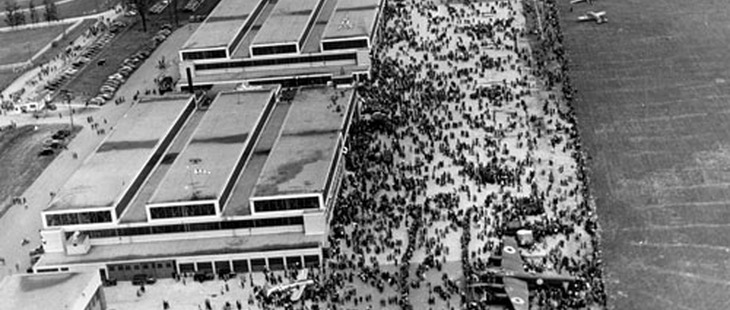
As the city emerges from recession, and finds its feet in an increasingly knowledge-based and global economy, the Standard takes a regular, sector-by-sector survey of Toronto industry. Which businesses are thriving, which are struggling, and which are running out of time. Previously: Food.
On Friday morning, NASA’s 30-year-old space shuttle program staged its final countdown, the Atlantis shuttle disappearing into the sky as an estimated million spectators watched from campsites and viewing stations, perhaps blasting David Bowie’s space travel coda, “Ashes to Ashes.” They could have hummed “O, Canada,” though, and it would have been just as appropriate. The shutdown of the program that launched in 1981 also means the end of the road for the first generation of Canadarms, the robotic arms so essential to the space shuttles, which were designed at the same time. (The larger, later-model Canadarm 2 will remain in service on the International Space Station.)
But you know that already from Canadian history 101. What you might not know is that the Canadarm’s giant robotic limbs hail from Brampton, Ontario, where they were designed and built by Canadian firm SPAR Aerospace, since acquired by another Canadian company, MacDonald, Dettwiler and Associates (MDA). And Brampton remains a “major centre for space robotics in Canada,” according to Rod Jones, executive director of the Ontario Aerospace Council (OAC).
The Canadarm is no doubt among the more famous pieces of high-tech gadgetry to ever emerge from Toronto’s suburbs. But it’s not the only one from the GTA, where firms design and manufacture $6 billion worth of aerospace goods a year—most of it exported out of Canada. Toronto’s aerospace cluster may get little attention compared to its bigger sister in Montreal, where it makes up a larger proportion of Quebec industry. But aerospace is still a crucial hub of innovation here, a meeting point between the city’s growing knowledge economy and the older manufacturing base. According to Rod Jones, executive director of the Ontario Aerospace Council (OAC), not only is Brampton a “major centre for space robotics in Canada,” but Toronto ranks among the top aircraft-producing cities in the world.
And that aerospace presence in Toronto has been around for “oh, about a hundred years,” says Frank Bedard, the city’s aerospace cluster specialist.
We do it all, from building planes to making parts. In its 1.7 million square-foot Downsview Park location, Bombardier takes air systems, landing gear and engines (some made locally) and assembles aircraft—one of only seven places in the world where such an endlessly complex and delicate thing takes place. In Mississauga, Honeywell designs environmental control systems for Boeing commercial jets, which take air from the engines on and treat it, giving passengers warm, clean and properly pressurized air while they jet through an external temperatures of about minus 65 degrees Celsius. Also in Mississauga, rising fuel prices have pushed Pratt & Whitney to develop the PW307, which they say is the greenest engine in its market with 33 per cent lower emissions than the standard set by the International Civil Aviation Organization.
Two hundred manufacturers employ a workforce of more than 20,000 in the GTA cluster, which has its big centre at Downsview Park’s magnificent, old de Havilland airplane hangars and its Bombardier facility, the latter being the largest single manufacturing employer in the city. Despite the rising price of fuel, the industry is also growing as the global economy expands and China and India demand more access to air travel.
“The entire aerospace industry grows about four to five per cent a year, and it’s done that for the last 40 or 50 years, and the expectation is that will continue, because air travel grows with economic activity on a global basis,” says Jones.
The de Havilland facility opened in 1928, and would eventually supply Mosquito combat planes to the U.K.’s Royal Air Force during the Second World War, when the wooden aircraft did bombing raids on Axis security bases and P.O.W. camps. And, of course, the Avro facility produced the famous Arrow in Malton until its untimely 1959 closure.
De Havilland also produced a line of planes designed for Canada’s cold climate—planes with adorable names like the Chipmunk, the Beaver, the Otter, the Caribou and the Buffalo. (We’re not kidding.)
The existence of the de Havilland facility eventually made it easier for later firms such as Bombardier—which refurbished part of it for its own use—to operate in the GTA, says Bedard.
“A 17,000-foot runway so you can assemble the aircraft and fly them out. That’s an important piece of infrastructure,” he says.
Yet aerospace in the city has suffered from neglect, both in terms of government funding and official recognition. Just ask Robert Cohen, communications manager at Downsview’s Canadian Air & Space Museum, who says the local aviation community is still smarting from the loss of two historic Downsview hangars, demolished last year despite heritage buffs’ attempts to save them.
He says the loss of the hangars was a symptom of a larger pattern of popular indifference to local aviation history.
“We (at the museum) occupy 30,000 square feet. We should have 300,000,” he says. “Nobody has really been forthright with promoting to the GTA the (aviation) industries and what they’ve accomplished. . . . It’s really kind of pathetic.”
The GTA cluster has also been historically underfunded compared with the industry in Quebec, which has benefited from major subsidies. A recent aerospace report card commissioned by the Aerospace Industries Association of Canada from consulting firm Deloitte & Touche gave Canada a ‘D’ with respect to government programs.
“There has been no appropriate mechanism in Ontario that invests in research and development in aerospace,” says Jones, who explained the low funding by pointing to aerospace’s small stake in Ontario business as a whole. Plus, he says, it takes a long time to see the fruit of investment in aerospace, where new programs operate on ten-year cycles. “There’s a faster return on other sectors. Governments tend to have shorter horizons than that.”
The situation has improved in recent years. In response to calls for change from the industry, a ten-year aerospace strategy was launched in 2005 that partnered all three levels of government with representatives of academia and business. That led to the development of a few key incentives, the most prominent being the provincial Advanced Manufacturing Investment Strategy (AMIS), which has poured about $42 million into Ontario aerospace firms over the last few years. Jones estimates that cash has leveraged about $170-200 million in total investments, which he expects to begin bearing fruit by around 2015.
Ontario is also looking to emulate the Consortium for Research and Innovation in Aerospace in Quebec (CRIAQ), a centre that provides incentives for research and development, says Jones.
Aerospace needs all the help it can get as it battles a strong Canadian dollar—poison for any export-based economy. It’s also struggling to attract new grads.
It isn’t just the heritage community that’s troubled by Toronto aviation’s lack of visibility. The industry is suffering from a human resources problem, as its workforce ages and young engineering grads skip aerospace for other career options. The OAC has pledged to better market the industry to university students, and Bombardier funds training programs for graduates of institutions such as the University of Toronto and Ryerson.
It is hoped that a planned “aerospace campus” in Downsview Park, with space for industry, residential and academia alongside Downsview subway station, will help revitalize perceptions of the industry.
“It’s long overdue,” says Cohen. “Any kind of development will bring a richer base to the community.”
_____
Toronto Aerospace Fact Box:
+ The GTA produces more than $6 billion annually in aerospace sales
+ Over 200 aerospace manufacturing firms in the GTA
+ Aerospace employs over 20,000 in the GTA
+ Aerospace are about five per cent of the Toronto manufacturing sector
+ Exports represent 80 per cent of Ontario’s aerospace industry
+ Toronto produced the first Canadian airplane, the Curtiss JN-4 Canuck in 1917
+ Toronto made the world’s first commercial jet transport to fly in the Western hemisphere, the Avro C-102 Jetliner in 1949
(Sources: The Ontario Aerospace Council and the City of Toronto)














